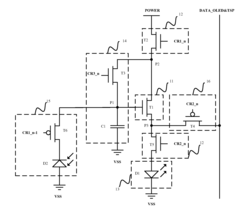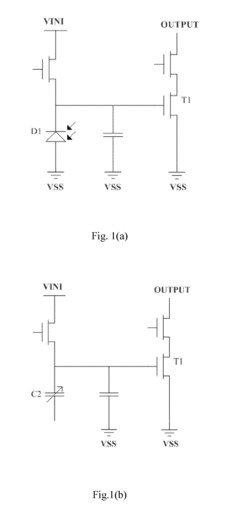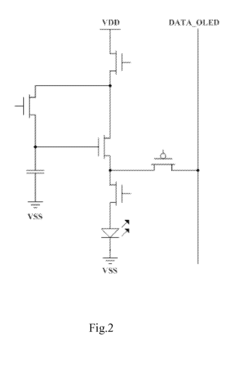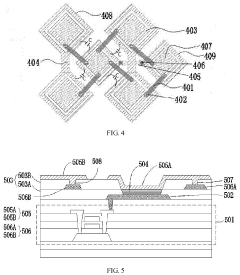How AMOLED promotes connectivity in digital classrooms?
JUL 17, 20259 MIN READ
Generate Your Research Report Instantly with AI Agent
Patsnap Eureka helps you evaluate technical feasibility & market potential.
AMOLED in Education: Background and Objectives
Active-Matrix Organic Light-Emitting Diode (AMOLED) technology has emerged as a revolutionary force in display technology, with its potential to transform various sectors, including education. The integration of AMOLED displays in digital classrooms represents a significant leap forward in enhancing connectivity and interactive learning experiences.
AMOLED technology, first introduced in the early 2000s, has rapidly evolved to become a preferred choice for high-quality displays in various electronic devices. Its superior color reproduction, high contrast ratios, and energy efficiency make it an ideal candidate for educational applications. The technology's ability to produce vibrant, true-to-life images and its flexibility in form factor have opened up new possibilities for interactive learning tools and immersive educational content.
The primary objective of incorporating AMOLED technology in digital classrooms is to create a more engaging and interactive learning environment. By leveraging the superior visual quality of AMOLED displays, educators aim to capture students' attention more effectively and facilitate better information retention. The technology's potential to support touch-sensitive interfaces also aligns with the growing trend of hands-on, interactive learning methodologies.
Another key goal is to enhance connectivity within the classroom ecosystem. AMOLED displays, when integrated with smart classroom systems, can serve as central hubs for information sharing, collaborative work, and real-time feedback. This connectivity extends beyond the physical classroom, enabling seamless integration with remote learning platforms and supporting the increasing demand for hybrid educational models.
The evolution of AMOLED technology in education is closely tied to broader trends in educational technology. As schools and institutions increasingly adopt digital learning tools, the demand for high-quality, energy-efficient displays has grown. AMOLED's trajectory in the education sector is influenced by factors such as the push for more immersive learning experiences, the need for flexible and adaptable classroom technologies, and the growing emphasis on visual learning in modern pedagogical approaches.
Looking ahead, the integration of AMOLED technology in digital classrooms is expected to drive innovations in educational content creation and delivery. The technology's capabilities open up possibilities for more sophisticated educational software, augmented reality applications, and interactive textbooks. These advancements have the potential to revolutionize how students interact with educational content, fostering a more dynamic and engaging learning environment.
As we explore the role of AMOLED in promoting connectivity in digital classrooms, it is crucial to consider both the technological advancements and the pedagogical implications. This technology not only promises to enhance the visual aspect of learning but also to fundamentally change how information is presented, shared, and interacted with in educational settings. The following sections of this report will delve deeper into these aspects, examining the current state of AMOLED technology in education, its market potential, and the challenges and opportunities that lie ahead.
AMOLED technology, first introduced in the early 2000s, has rapidly evolved to become a preferred choice for high-quality displays in various electronic devices. Its superior color reproduction, high contrast ratios, and energy efficiency make it an ideal candidate for educational applications. The technology's ability to produce vibrant, true-to-life images and its flexibility in form factor have opened up new possibilities for interactive learning tools and immersive educational content.
The primary objective of incorporating AMOLED technology in digital classrooms is to create a more engaging and interactive learning environment. By leveraging the superior visual quality of AMOLED displays, educators aim to capture students' attention more effectively and facilitate better information retention. The technology's potential to support touch-sensitive interfaces also aligns with the growing trend of hands-on, interactive learning methodologies.
Another key goal is to enhance connectivity within the classroom ecosystem. AMOLED displays, when integrated with smart classroom systems, can serve as central hubs for information sharing, collaborative work, and real-time feedback. This connectivity extends beyond the physical classroom, enabling seamless integration with remote learning platforms and supporting the increasing demand for hybrid educational models.
The evolution of AMOLED technology in education is closely tied to broader trends in educational technology. As schools and institutions increasingly adopt digital learning tools, the demand for high-quality, energy-efficient displays has grown. AMOLED's trajectory in the education sector is influenced by factors such as the push for more immersive learning experiences, the need for flexible and adaptable classroom technologies, and the growing emphasis on visual learning in modern pedagogical approaches.
Looking ahead, the integration of AMOLED technology in digital classrooms is expected to drive innovations in educational content creation and delivery. The technology's capabilities open up possibilities for more sophisticated educational software, augmented reality applications, and interactive textbooks. These advancements have the potential to revolutionize how students interact with educational content, fostering a more dynamic and engaging learning environment.
As we explore the role of AMOLED in promoting connectivity in digital classrooms, it is crucial to consider both the technological advancements and the pedagogical implications. This technology not only promises to enhance the visual aspect of learning but also to fundamentally change how information is presented, shared, and interacted with in educational settings. The following sections of this report will delve deeper into these aspects, examining the current state of AMOLED technology in education, its market potential, and the challenges and opportunities that lie ahead.
Digital Classroom Market Analysis
The digital classroom market has experienced significant growth in recent years, driven by the increasing adoption of technology in education and the shift towards more interactive and engaging learning experiences. This trend has been further accelerated by the global pandemic, which forced many educational institutions to rapidly adopt remote and hybrid learning models.
The market for digital classroom solutions is expected to continue its upward trajectory, with a compound annual growth rate (CAGR) projected to remain in the double digits over the next five years. This growth is fueled by factors such as the increasing digitization of educational content, the rising demand for personalized learning experiences, and the growing emphasis on collaborative and interactive learning environments.
AMOLED (Active-Matrix Organic Light-Emitting Diode) technology plays a crucial role in promoting connectivity in digital classrooms by enhancing the visual experience and enabling more versatile display solutions. The superior image quality, high contrast ratios, and wide color gamut offered by AMOLED displays contribute to improved readability and reduced eye strain, which are essential for prolonged use in educational settings.
The demand for AMOLED displays in the education sector is driven by the need for high-quality visual content delivery, interactive whiteboards, and mobile devices used in digital classrooms. The technology's ability to produce vibrant colors and deep blacks makes it particularly suitable for displaying multimedia content, educational videos, and interactive simulations, enhancing student engagement and comprehension.
Furthermore, the flexibility of AMOLED technology allows for the development of innovative form factors, such as foldable or rollable displays, which can revolutionize the way educational content is presented and interacted with in digital classrooms. This adaptability opens up new possibilities for collaborative learning and seamless integration of technology into various educational environments.
The market for AMOLED displays in education is closely tied to the broader trends in the digital classroom market, including the adoption of smart boards, tablets, and other connected devices. As schools and universities invest in upgrading their infrastructure to support more immersive and interactive learning experiences, the demand for high-quality display technologies like AMOLED is expected to grow.
However, the adoption of AMOLED technology in digital classrooms also faces challenges, such as the higher cost compared to traditional display technologies and concerns about durability in educational settings. Overcoming these barriers will be crucial for wider adoption and market penetration in the education sector.
The market for digital classroom solutions is expected to continue its upward trajectory, with a compound annual growth rate (CAGR) projected to remain in the double digits over the next five years. This growth is fueled by factors such as the increasing digitization of educational content, the rising demand for personalized learning experiences, and the growing emphasis on collaborative and interactive learning environments.
AMOLED (Active-Matrix Organic Light-Emitting Diode) technology plays a crucial role in promoting connectivity in digital classrooms by enhancing the visual experience and enabling more versatile display solutions. The superior image quality, high contrast ratios, and wide color gamut offered by AMOLED displays contribute to improved readability and reduced eye strain, which are essential for prolonged use in educational settings.
The demand for AMOLED displays in the education sector is driven by the need for high-quality visual content delivery, interactive whiteboards, and mobile devices used in digital classrooms. The technology's ability to produce vibrant colors and deep blacks makes it particularly suitable for displaying multimedia content, educational videos, and interactive simulations, enhancing student engagement and comprehension.
Furthermore, the flexibility of AMOLED technology allows for the development of innovative form factors, such as foldable or rollable displays, which can revolutionize the way educational content is presented and interacted with in digital classrooms. This adaptability opens up new possibilities for collaborative learning and seamless integration of technology into various educational environments.
The market for AMOLED displays in education is closely tied to the broader trends in the digital classroom market, including the adoption of smart boards, tablets, and other connected devices. As schools and universities invest in upgrading their infrastructure to support more immersive and interactive learning experiences, the demand for high-quality display technologies like AMOLED is expected to grow.
However, the adoption of AMOLED technology in digital classrooms also faces challenges, such as the higher cost compared to traditional display technologies and concerns about durability in educational settings. Overcoming these barriers will be crucial for wider adoption and market penetration in the education sector.
AMOLED Technology: Current State and Challenges
AMOLED (Active-Matrix Organic Light-Emitting Diode) technology has made significant strides in recent years, revolutionizing display technology across various devices. In the context of digital classrooms, AMOLED displays offer several advantages that enhance connectivity and learning experiences. However, the technology also faces certain challenges that need to be addressed for wider adoption in educational settings.
The current state of AMOLED technology in digital classrooms is characterized by its superior image quality, energy efficiency, and flexibility. AMOLED displays provide vibrant colors, high contrast ratios, and wide viewing angles, which are crucial for presenting educational content effectively. These features enable students to clearly view and interact with digital materials, promoting better engagement and understanding.
One of the key advantages of AMOLED in digital classrooms is its potential for creating flexible and foldable displays. This opens up new possibilities for interactive learning experiences, allowing students to manipulate and explore digital content in more intuitive ways. Additionally, AMOLED's energy efficiency contributes to longer battery life in portable devices, ensuring uninterrupted learning sessions.
Despite these benefits, AMOLED technology faces several challenges in the educational sector. Cost remains a significant barrier, as AMOLED displays are generally more expensive than traditional LCD screens. This limits their widespread adoption in budget-constrained educational institutions. Durability is another concern, particularly in the high-wear environment of classrooms, where devices may be subjected to frequent handling and potential damage.
Another challenge is the potential for screen burn-in, where static images can leave permanent marks on the display. This is particularly problematic in educational settings where certain interface elements or content may be displayed for extended periods. Manufacturers are working on mitigating this issue through various software and hardware solutions, but it remains a consideration for long-term use in classrooms.
The integration of touch functionality with AMOLED displays also presents both opportunities and challenges. While it enables more interactive learning experiences, it can increase the complexity and cost of the devices. Ensuring accurate and responsive touch input across various environmental conditions is crucial for effective use in educational settings.
As AMOLED technology continues to evolve, researchers and manufacturers are focusing on addressing these challenges. Efforts are being made to reduce production costs, improve durability, and enhance longevity. Additionally, there is ongoing research into incorporating advanced features such as in-display cameras and sensors, which could further enhance the connectivity and functionality of digital classroom devices.
In conclusion, while AMOLED technology offers significant potential for promoting connectivity in digital classrooms, it still faces several hurdles. Overcoming these challenges will be crucial for its widespread adoption and integration into educational technology ecosystems.
The current state of AMOLED technology in digital classrooms is characterized by its superior image quality, energy efficiency, and flexibility. AMOLED displays provide vibrant colors, high contrast ratios, and wide viewing angles, which are crucial for presenting educational content effectively. These features enable students to clearly view and interact with digital materials, promoting better engagement and understanding.
One of the key advantages of AMOLED in digital classrooms is its potential for creating flexible and foldable displays. This opens up new possibilities for interactive learning experiences, allowing students to manipulate and explore digital content in more intuitive ways. Additionally, AMOLED's energy efficiency contributes to longer battery life in portable devices, ensuring uninterrupted learning sessions.
Despite these benefits, AMOLED technology faces several challenges in the educational sector. Cost remains a significant barrier, as AMOLED displays are generally more expensive than traditional LCD screens. This limits their widespread adoption in budget-constrained educational institutions. Durability is another concern, particularly in the high-wear environment of classrooms, where devices may be subjected to frequent handling and potential damage.
Another challenge is the potential for screen burn-in, where static images can leave permanent marks on the display. This is particularly problematic in educational settings where certain interface elements or content may be displayed for extended periods. Manufacturers are working on mitigating this issue through various software and hardware solutions, but it remains a consideration for long-term use in classrooms.
The integration of touch functionality with AMOLED displays also presents both opportunities and challenges. While it enables more interactive learning experiences, it can increase the complexity and cost of the devices. Ensuring accurate and responsive touch input across various environmental conditions is crucial for effective use in educational settings.
As AMOLED technology continues to evolve, researchers and manufacturers are focusing on addressing these challenges. Efforts are being made to reduce production costs, improve durability, and enhance longevity. Additionally, there is ongoing research into incorporating advanced features such as in-display cameras and sensors, which could further enhance the connectivity and functionality of digital classroom devices.
In conclusion, while AMOLED technology offers significant potential for promoting connectivity in digital classrooms, it still faces several hurdles. Overcoming these challenges will be crucial for its widespread adoption and integration into educational technology ecosystems.
AMOLED Solutions for Digital Classrooms
01 AMOLED display connectivity and control
This category focuses on the connectivity and control mechanisms for AMOLED displays. It includes technologies for driving and controlling AMOLED panels, such as data line driving circuits, scan line driving circuits, and pixel control methods. These innovations aim to improve display performance, reduce power consumption, and enhance overall display quality.- AMOLED display connectivity and control: This category focuses on the connectivity and control mechanisms for AMOLED displays. It includes technologies for driving and controlling AMOLED panels, such as data line driving circuits, scan line driving circuits, and pixel control methods. These innovations aim to improve display performance, reduce power consumption, and enhance overall display quality.
- AMOLED panel structure and fabrication: This category covers advancements in AMOLED panel structure and fabrication techniques. It includes innovations in pixel design, thin-film transistor (TFT) structures, and manufacturing processes for AMOLED displays. These technologies aim to improve display efficiency, color accuracy, and durability while reducing production costs.
- AMOLED power management and efficiency: This category focuses on power management and efficiency improvements for AMOLED displays. It includes technologies for reducing power consumption, optimizing voltage distribution, and enhancing overall energy efficiency of AMOLED panels. These innovations aim to extend battery life in mobile devices and improve the sustainability of AMOLED technology.
- AMOLED touch integration and sensing: This category covers the integration of touch sensing capabilities with AMOLED displays. It includes technologies for in-cell and on-cell touch sensors, as well as innovations in touch detection and processing for AMOLED panels. These advancements aim to improve touch responsiveness, reduce display thickness, and enhance user interaction with AMOLED devices.
- AMOLED display image quality enhancement: This category focuses on technologies for improving image quality in AMOLED displays. It includes innovations in color management, contrast enhancement, and pixel compensation techniques. These advancements aim to deliver more vibrant, accurate, and consistent visual experiences across various AMOLED display applications.
02 AMOLED pixel structure and manufacturing
This category covers advancements in AMOLED pixel structures and manufacturing processes. It includes innovations in pixel design, such as sub-pixel arrangements and light-emitting layer compositions. These technologies aim to improve color accuracy, brightness, and longevity of AMOLED displays while optimizing production efficiency.Expand Specific Solutions03 Touch integration in AMOLED displays
This category focuses on integrating touch functionality into AMOLED displays. It includes technologies for in-cell or on-cell touch sensors, touch detection circuits, and methods for combining touch and display functions. These innovations aim to create thinner, more responsive touchscreen AMOLED devices with improved user interaction.Expand Specific Solutions04 Power management and efficiency in AMOLED displays
This category covers technologies related to power management and efficiency improvements in AMOLED displays. It includes innovations in power supply circuits, voltage regulation, and power-saving modes. These advancements aim to extend battery life, reduce heat generation, and optimize overall energy consumption in AMOLED-equipped devices.Expand Specific Solutions05 AMOLED display signal processing and image quality enhancement
This category focuses on signal processing and image quality enhancement techniques for AMOLED displays. It includes technologies for color management, contrast improvement, motion blur reduction, and HDR implementation. These innovations aim to optimize visual performance and create more immersive viewing experiences on AMOLED screens.Expand Specific Solutions
Key Players in AMOLED and EdTech Industries
The AMOLED technology in digital classrooms is in its early growth stage, with increasing market potential as educational institutions adopt smart displays. The market size is expanding, driven by the demand for interactive and immersive learning experiences. Technologically, AMOLED displays are maturing rapidly, with key players like Samsung Electronics, BOE Technology, and Tianma Microelectronics leading innovation. These companies are developing thinner, more energy-efficient displays with enhanced color accuracy and touch responsiveness, crucial for educational applications. The competition is intensifying as more manufacturers enter the market, potentially accelerating technological advancements and reducing costs for widespread adoption in digital classrooms.
BOE Technology Group Co., Ltd.
Technical Solution: BOE has developed flexible AMOLED displays specifically tailored for educational applications. Their technology incorporates low-temperature polycrystalline oxide (LTPO) backplanes, allowing for variable refresh rates that optimize power consumption in classroom settings[4]. BOE's AMOLED displays feature high pixel density (up to 400 PPI) and wide color gamut coverage (100% DCI-P3), ensuring clear and vibrant visuals for educational content[5]. The company has also implemented touch integration and stylus support, facilitating interactive learning experiences. BOE's displays include blue light reduction technology and flicker-free operation to enhance eye comfort during prolonged use in digital classrooms[6].
Strengths: Advanced display technology with power-saving features and interactive capabilities. Weaknesses: May face challenges in large-scale production and cost-effectiveness for widespread educational adoption.
Tianma Microelectronics Co., Ltd.
Technical Solution: Tianma has developed AMOLED displays with a focus on durability and longevity for educational environments. Their panels incorporate advanced thin-film encapsulation (TFE) technology to protect against moisture and oxygen, ensuring longer lifespan in classroom settings[9]. Tianma's AMOLED displays feature high brightness levels (up to 1000 nits) and wide viewing angles, enhancing visibility for group learning scenarios. The company has also implemented multi-touch technology with up to 10-point touch recognition, supporting collaborative activities in digital classrooms. Tianma's displays include blue light filtering and anti-flicker technology to reduce eye strain during extended use[10].
Strengths: Durable design suitable for classroom environments and advanced touch capabilities. Weaknesses: May have less brand recognition in the education sector compared to larger consumer electronics companies.
Innovations in AMOLED for Educational Applications
Active matrix organic light emitting diode pixel unit circuit, display panel and electronic product
PatentActiveUS9459721B2
Innovation
- The AMOLED pixel unit circuit is redesigned to include a light emitting module, a driving module, a threshold compensating module, a light emission controlling module, a touch sensing module, and an induction signal outputting module, which utilize existing data lines and control signals to integrate the TSP in Cell circuit, sharing circuit elements and control signals to minimize additional components.
Active matrix organic light emitting diode (amoled) display panel
PatentInactiveUS20210343972A1
Innovation
- The integration of sensing electrodes into the AMOLED display panel allows for underscreen fingerprint identification, utilizing a patterned cathode layer with insulated first and second electrode rows and conductive bridges to form capacitors for fingerprint recognition, thereby embedding fingerprint identification within the screen and increasing the display area ratio.
Impact on Student Engagement and Learning Outcomes
The integration of AMOLED technology in digital classrooms has significantly impacted student engagement and learning outcomes. The high-quality visual experience provided by AMOLED displays enhances students' attention and focus during lessons, leading to improved information retention and comprehension.
AMOLED screens offer vibrant colors, deep blacks, and high contrast ratios, which make educational content more visually appealing and easier to read. This enhanced visual clarity reduces eye strain and fatigue, allowing students to maintain concentration for longer periods. As a result, students can engage more effectively with digital learning materials, interactive simulations, and multimedia presentations.
The superior color reproduction of AMOLED displays enables more accurate representation of complex scientific concepts, artistic works, and historical artifacts. This level of detail and accuracy enhances students' understanding of various subjects, particularly in fields such as biology, chemistry, and art history, where visual representation is crucial.
AMOLED technology's energy efficiency and thin form factor contribute to the development of more portable and lightweight devices for classroom use. This increased mobility allows for greater flexibility in classroom layouts and promotes collaborative learning environments. Students can easily move around the classroom, share screens, and work together on group projects, fostering peer-to-peer learning and improving social skills.
The responsiveness of AMOLED touchscreens enhances the interactive nature of digital learning tools. Students can manipulate on-screen objects, draw, and write with greater precision, leading to a more intuitive and engaging learning experience. This interactivity promotes active learning and helps students develop critical thinking and problem-solving skills.
AMOLED displays' ability to show true blacks and high contrast ratios improves the visibility of content in various lighting conditions. This adaptability ensures that students can effectively engage with digital materials regardless of the classroom environment, promoting consistent learning experiences across different settings.
The integration of AMOLED technology in digital classrooms has also been shown to increase student motivation and enthusiasm for learning. The visually appealing and interactive nature of AMOLED-equipped devices makes educational content more engaging and enjoyable, leading to higher levels of student participation and interest in academic subjects.
In conclusion, the adoption of AMOLED technology in digital classrooms has had a profound impact on student engagement and learning outcomes. By providing enhanced visual experiences, promoting interactivity, and enabling more flexible learning environments, AMOLED displays have become a valuable tool in modern education, contributing to improved academic performance and a more engaging learning experience for students.
AMOLED screens offer vibrant colors, deep blacks, and high contrast ratios, which make educational content more visually appealing and easier to read. This enhanced visual clarity reduces eye strain and fatigue, allowing students to maintain concentration for longer periods. As a result, students can engage more effectively with digital learning materials, interactive simulations, and multimedia presentations.
The superior color reproduction of AMOLED displays enables more accurate representation of complex scientific concepts, artistic works, and historical artifacts. This level of detail and accuracy enhances students' understanding of various subjects, particularly in fields such as biology, chemistry, and art history, where visual representation is crucial.
AMOLED technology's energy efficiency and thin form factor contribute to the development of more portable and lightweight devices for classroom use. This increased mobility allows for greater flexibility in classroom layouts and promotes collaborative learning environments. Students can easily move around the classroom, share screens, and work together on group projects, fostering peer-to-peer learning and improving social skills.
The responsiveness of AMOLED touchscreens enhances the interactive nature of digital learning tools. Students can manipulate on-screen objects, draw, and write with greater precision, leading to a more intuitive and engaging learning experience. This interactivity promotes active learning and helps students develop critical thinking and problem-solving skills.
AMOLED displays' ability to show true blacks and high contrast ratios improves the visibility of content in various lighting conditions. This adaptability ensures that students can effectively engage with digital materials regardless of the classroom environment, promoting consistent learning experiences across different settings.
The integration of AMOLED technology in digital classrooms has also been shown to increase student motivation and enthusiasm for learning. The visually appealing and interactive nature of AMOLED-equipped devices makes educational content more engaging and enjoyable, leading to higher levels of student participation and interest in academic subjects.
In conclusion, the adoption of AMOLED technology in digital classrooms has had a profound impact on student engagement and learning outcomes. By providing enhanced visual experiences, promoting interactivity, and enabling more flexible learning environments, AMOLED displays have become a valuable tool in modern education, contributing to improved academic performance and a more engaging learning experience for students.
Sustainability and Energy Efficiency in Educational Technology
The integration of AMOLED technology in digital classrooms has significant implications for sustainability and energy efficiency in educational technology. AMOLED displays offer superior energy efficiency compared to traditional LCD screens, consuming less power while providing vibrant colors and high contrast ratios. This reduced energy consumption translates to lower electricity costs for educational institutions and decreased environmental impact.
AMOLED screens can selectively illuminate individual pixels, allowing for true blacks by turning off pixels entirely. This feature not only enhances visual quality but also contributes to energy savings, especially when displaying darker content or using dark mode in educational applications. The ability to power down unused pixels results in substantial power savings over time, particularly in scenarios where not all screen areas are constantly in use.
The longevity of AMOLED displays is another factor contributing to sustainability in educational technology. These screens typically have a longer lifespan than their LCD counterparts, reducing the frequency of replacements and minimizing electronic waste. This durability is especially beneficial in classroom settings where devices may be subject to frequent use and potential wear and tear.
AMOLED technology also enables the development of flexible and foldable displays, which can lead to more versatile and space-efficient educational devices. This adaptability can result in reduced material usage and energy consumption in the production and transportation of educational technology hardware.
Furthermore, the superior color reproduction and contrast of AMOLED displays can enhance the visual learning experience, potentially reducing eye strain and the need for high brightness settings. This not only improves student comfort but also contributes to overall energy efficiency in digital classrooms.
As AMOLED technology continues to advance, it is likely to play an increasingly important role in creating more sustainable and energy-efficient educational environments. The ongoing development of this technology may lead to even greater power savings and improved durability, further reducing the environmental footprint of digital classrooms while enhancing the quality of educational experiences.
AMOLED screens can selectively illuminate individual pixels, allowing for true blacks by turning off pixels entirely. This feature not only enhances visual quality but also contributes to energy savings, especially when displaying darker content or using dark mode in educational applications. The ability to power down unused pixels results in substantial power savings over time, particularly in scenarios where not all screen areas are constantly in use.
The longevity of AMOLED displays is another factor contributing to sustainability in educational technology. These screens typically have a longer lifespan than their LCD counterparts, reducing the frequency of replacements and minimizing electronic waste. This durability is especially beneficial in classroom settings where devices may be subject to frequent use and potential wear and tear.
AMOLED technology also enables the development of flexible and foldable displays, which can lead to more versatile and space-efficient educational devices. This adaptability can result in reduced material usage and energy consumption in the production and transportation of educational technology hardware.
Furthermore, the superior color reproduction and contrast of AMOLED displays can enhance the visual learning experience, potentially reducing eye strain and the need for high brightness settings. This not only improves student comfort but also contributes to overall energy efficiency in digital classrooms.
As AMOLED technology continues to advance, it is likely to play an increasingly important role in creating more sustainable and energy-efficient educational environments. The ongoing development of this technology may lead to even greater power savings and improved durability, further reducing the environmental footprint of digital classrooms while enhancing the quality of educational experiences.
Unlock deeper insights with Patsnap Eureka Quick Research — get a full tech report to explore trends and direct your research. Try now!
Generate Your Research Report Instantly with AI Agent
Supercharge your innovation with Patsnap Eureka AI Agent Platform!







